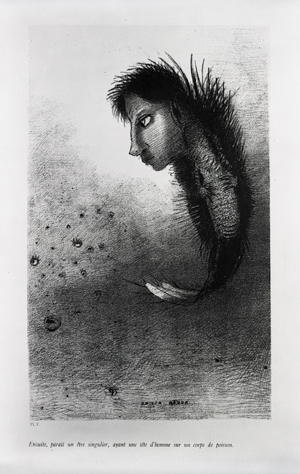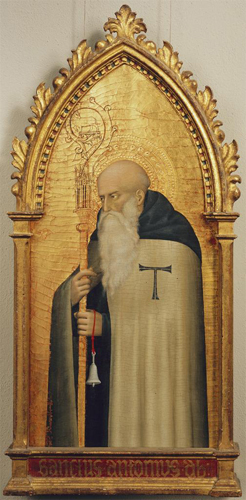Dates:
Location:
Markell Gallery
Saint Anthony (ca. 251–356), often regarded as the founder of Christian monasticism, was a hermit in the Egyptian desert who, according to his biographer Athanasius of Alexandria, was tormented by supernatural appearances. This exhibition presents renderings of Saint Anthony’s visions since the late medieval period.
Selected Works

"The Temptation of Saint Anthony," Plate V, 1888, lithograph by Odilon Redon. Bowdoin College Museum of Art.

"St. Anthony Abbot," ca. 1365, tempera on panel by Giovanni da Milano. Williams College Museum of Art, gift of the Samuel H. Kress Foundation.
About
In a world often troubled by deceit, how can one recognize the truth? How can art—itself a form of make-believe—help to reveal what is right? For many European artists who were pondering the nature of images, the legend of the Egyptian hermit Saint Anthony provided inspiration. Scores of demons attempted and failed to distract Anthony from his devotion. The Saint’s ability to distinguish between godly and evil apparitions made him a model for artists who sought to establish the truthfulness of their own imagination and sought license for their creative fantasy.
Anthony “the Great” (ca. 251–356) is often credited with establishing Christian monasticism. Born into a wealthy family in the area of Arsionë in Upper Egypt, Anthony gave away his inheritance at age twenty and retreated into the desert between the Nile and the Red Sea, where he became a widely respected ascetic. Anthony’s friend, the bishop of Alexandria Athanasius wrote the Vita Antonii, which was immediately translated into different languages and has been called the most influential biography in Christian history.
With the description of Anthony’s asceticism as a form of spiritual purification and voluntary rather than inflicted martyrdom, the biography expanded the hagiographical tradition. It provided not only a model for Christian believers throughout the ages, but it also attracted the attention of many artists. This exhibition reveals an ongoing artistic fascination with the legend that began in late medieval Europe and continues to this day.
Anthony “the Great” (ca. 251–356) is often credited with establishing Christian monasticism. Born into a wealthy family in the area of Arsionë in Upper Egypt, Anthony gave away his inheritance at age twenty and retreated into the desert between the Nile and the Red Sea, where he became a widely respected ascetic. Anthony’s friend, the bishop of Alexandria Athanasius wrote the Vita Antonii, which was immediately translated into different languages and has been called the most influential biography in Christian history.
With the description of Anthony’s asceticism as a form of spiritual purification and voluntary rather than inflicted martyrdom, the biography expanded the hagiographical tradition. It provided not only a model for Christian believers throughout the ages, but it also attracted the attention of many artists. This exhibition reveals an ongoing artistic fascination with the legend that began in late medieval Europe and continues to this day.
Press
Read a Bowdoin Daily Sun article about the exhibition.
Read a news story about the January 26 roundtable discussion "Iconoclasm and the Power of Images."
Multimedia Resources
Listen to an interview with Joachim Homann recorded on WBOR Radio, recorded on December 1, 2016 (audio may take a few seconds to load)
Watch a recording of "Iconoclasm and the Power of Images," a roundtable discussion which was presented at Bowdoin College on January 26, 2017.

